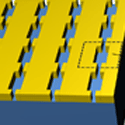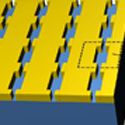Light Gets into the Double Groove
Enhancing, confining, and channeling light in subwavelength structures is key to numerous applications and devices in photonics, including infrared detectors, light emitting diodes, and microscopes. Up until now, the main mechanism to produce this effect involved surface plasmons excited on the surface of perforated or corrugated thin metal films in a process known as extraordinary optical transmission (EOT). However, because this is a resonant process, EOT has a narrow bandwidth.
Writing in Physical Review Letters, Ganapathi Subramania at Sandia National Labs, New Mexico, and colleagues propose an alternative subwavelength optical device that funnels light by means of a nonresonant process and is therefore broadband. Using numerical simulations, they study a double-groove structure consisting of a series of alternating small and large rectangular slits engraved on a thin gold film that rests on a dielectric substrate. The slits are connected, which traps the electromagnetic field into the groove structure via a nonresonant mechanism where the electrons respond nearly instantaneously to the incident field. The different relative sizes of the slits further confine light on the narrow slits and in the substrate directly below them. Subramania et al.’s calculations suggest that over a broad wavelength range ( – microns), light incident to the structure gets funneled efficiently in an ultrasubwavelength area as small as ( . By tuning the relative sizes of the slits, the authors can control the enhancement of the electric field, the confinement of power, and the transmission of energy across the structure. – Manolis Antonoyiannakis





